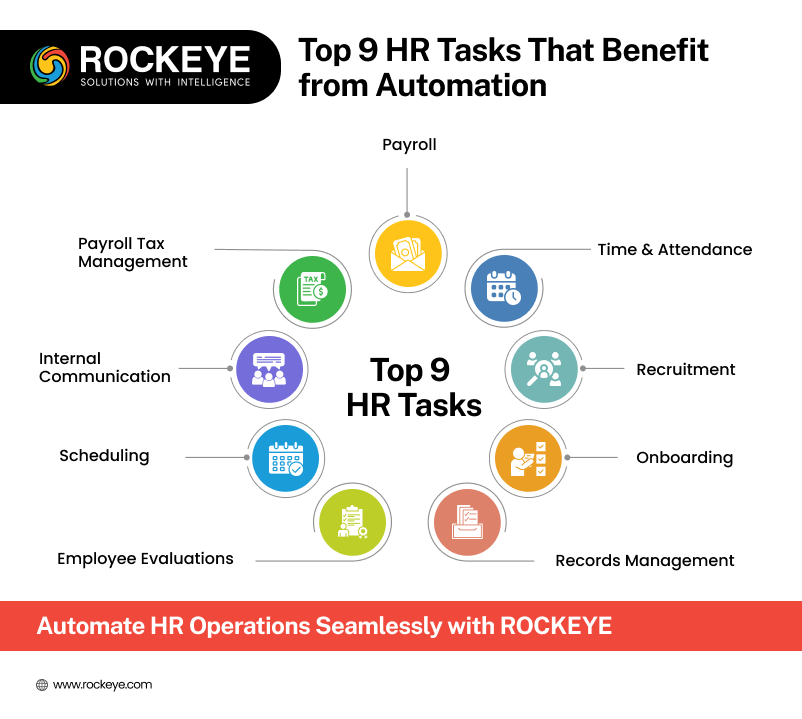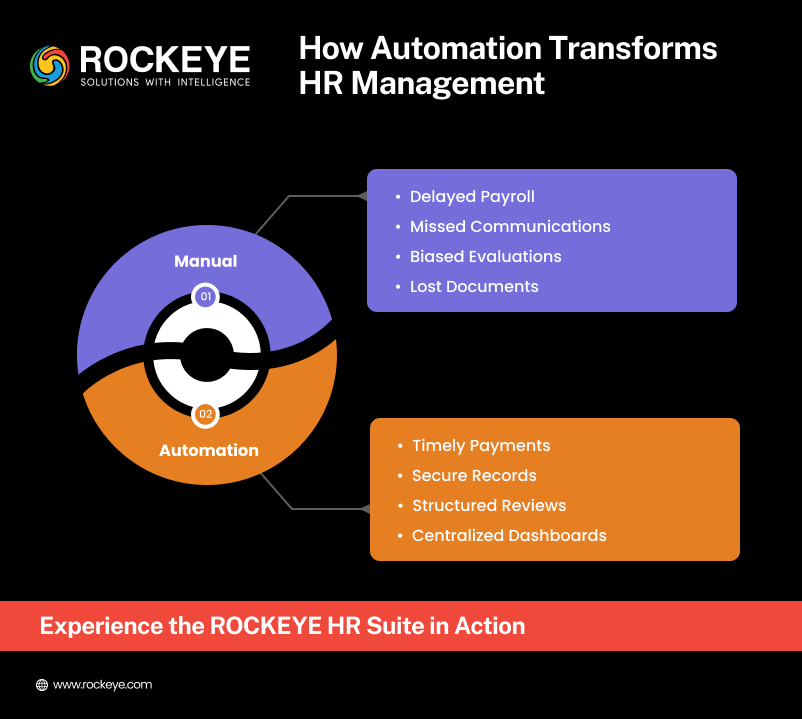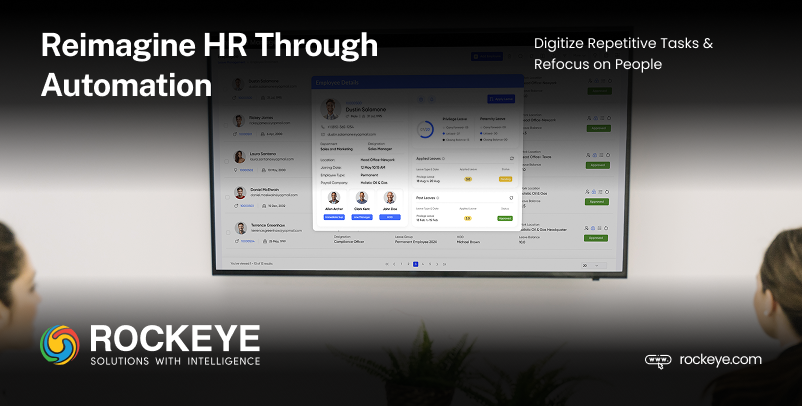The benefit of doing business in the digital age is the ability to automate functions that are crucial to operations. Human resources is one of the most important divisions within your organization, and automation saves time and effort. HR managers who have the capacity to do more than juggle tasks linked to payroll, benefits administration, tracking time and attendance, and organizing document storage perform better. The best way to ensure that HR leaders are exercising the talents that you hired them for is to automate as many of the human resource management tasks as possible, leaving them to the important work of actually managing employees and assisting employees in career management.

Payroll
Paying employees timely includes the need to know who your team members are, their rate of pay, whether they are hourly or salaried, time off accrued, and how much tax is deducted from their gross earnings. These are all components of payroll that are included in basic payroll systems and should be leveraged in any company as soon as it is financially feasible. Doing so saves time and money and creates the capacity necessary to grow your organization. According to experts, automating payroll decreases the associated costs by 3 to 5 percent.
Tracking Time
Security is a risk factor in any business utilizing digital systems, whether software-related or cloud-based. However, having a system that employees must use on their assigned devices as well as log in to track their time reduces the ability of others to illegally compromise timekeeping integrity. Attendance and time tracking systems also reduce human error and bias, which allows managers to evaluate employee performance linked to time and attendance and address issues without data complications. When employees know that timekeeping systems are used within the organization, it also promotes productivity in that work hours reported must be allocated to assigned tasks and roles. This allows managers to clearly identify where hours that employees are paid for are spent.
Recruitment
Application tracking tools can help make recruiting a seamless process for HR managers. Business Intelligence (BI) that scans application materials for keywords, phrases, sentence structure, experience tags, education level, and other preferred hiring requirements aids in removing human bias and judgment from the candidate review process. Recruitment automation also helps to streamline the communication process between hiring managers and candidates, reducing the error rate for communicating the wrong information to the wrong people. A discreet benefit of recruiting BI is the time saved by filtering applicants through a system-generated and managed recruiting workflow. Adjustments to the workflows are then standardized throughout the organization and applied to every applicant.
Onboarding
Onboarding can be a frustrating experience for both managers and new employees when using old-fashioned and outdated methods. Automating the onboarding process reduces potential mix-ups in schedules and orientation assignments and provides new team members with a sense of affirmation in their decision to join the team. The average employer spends about $4,100 to $4,129 according to recent studies by SHRM and related sources, and spends 52 days onboarding new employees. The best way to ensure that money and time are well spent is to deploy onboarding tools and processes that reduce frustration and encourage new employees to remain with your organization for the long haul.
Records Management
Cloud storage of employee information is very common these days; however, there must be a system-based interface for easy retrieval of data. Automated HR management tools provide the interface and functionality of managing documents necessary when hiring, whether full- or part-time, temporary or permanent, contract or standard employees. Automated HR records management systems should have a repository for tracking the government-required documents as well as an alert process for missing data. Without an automated records management system within your HR management workflow, an organization can be caught without the required documents on hand and suffer financial consequences or fines as a result.

Employee Evaluation
Performance reviews should take place regularly within your organization and can be easily automated to remain on schedule. Every valuable employee looks forward to understanding why their overall performance throughout the year is up to standard or needs improvement. Employee evaluations that occur outside of an automated system tend to be erratic, biased, and untimely, which in turn causes frustration among the team. Automated performance reviews eliminate human error and judgment, which is a relief to employees, as their annual salary increase and future state employment is usually determined by the evaluation outcomes. HR managers using automation for employee performance reviews have a more precise way of linking employee benchmarks and competencies to their assigned work efforts.
Scheduling
Competently executing management duties avoids resentment towards leaders by the employees they supervise. Automated HR management tools can help with scheduling on various levels and in different areas, such as interviews, regularly scheduled one-on-one meetings, and team training. Rather than manually scheduling appointments, the interaction between managers and employees or candidates can be preset within the tool features.
Communication
When HR management communication is automated, the right information gets to the right people. Similarities in names, especially in larger organizations, can result in human error and compromised confidentiality. Team collaborations are much smoother with automated HR management communication and amplify accuracy in timekeeping as well as project management. Some HR management automation tools are savvy enough to extract statements from pdf documents and deliver the applicable information to only the affected employees. Imagine the productivity increase gained when communication is transmitted throughout the day by deploying these types of tools.
Payroll Taxes
Ensuring the proper taxes are remitted to the government is a key function within payroll operations. There are components to calculating payroll taxes that can easily become cumbersome to any HR management or payroll department. HR management automation can track the amount of taxes an organization owes after paying employees. Automating your payroll taxes will not only save you time but also avoid costly mistakes that consume business resources and reserved funds.
Abstract: The digital and technological advances we’re experiencing today have resulted in many automated processes throughout business operations. HR management has seen a significant rise in automation, and this article outlines the most common functions that systems can manage.

FAQs:
Q1: Why should businesses automate HR management tasks?
Automating HR management tasks saves time and effort, allowing HR leaders to focus on managing employees and supporting career development rather than juggling repetitive administrative duties.
Q2: What components of payroll are typically included in automated systems?
Automated payroll systems handle employee details, pay rates, work types (hourly/salary), leave accruals, and tax deductions—creating efficiency and supporting business growth.
Q3: How does automation impact payroll costs?
According to experts, automating payroll decreases the associated costs by 3 to 5 percent.
Q4: How does automating time tracking improve business operations?
Time tracking systems reduce human error and bias, promote productivity, and allow managers to clearly identify how paid hours are being spent.
Q5: What role does automation play in recruitment?
Application tracking tools scan resumes for relevant hiring criteria and reduce human bias. They streamline communication and create standardized workflows.

